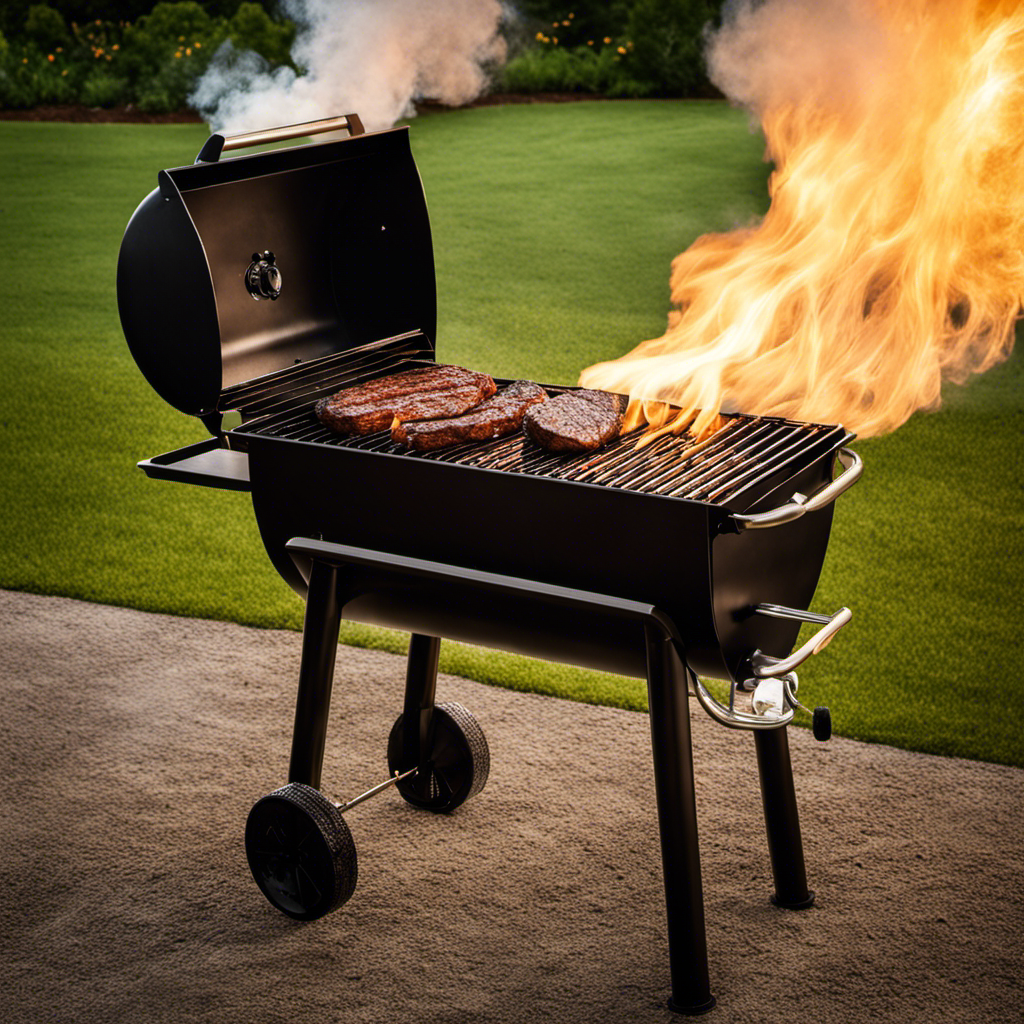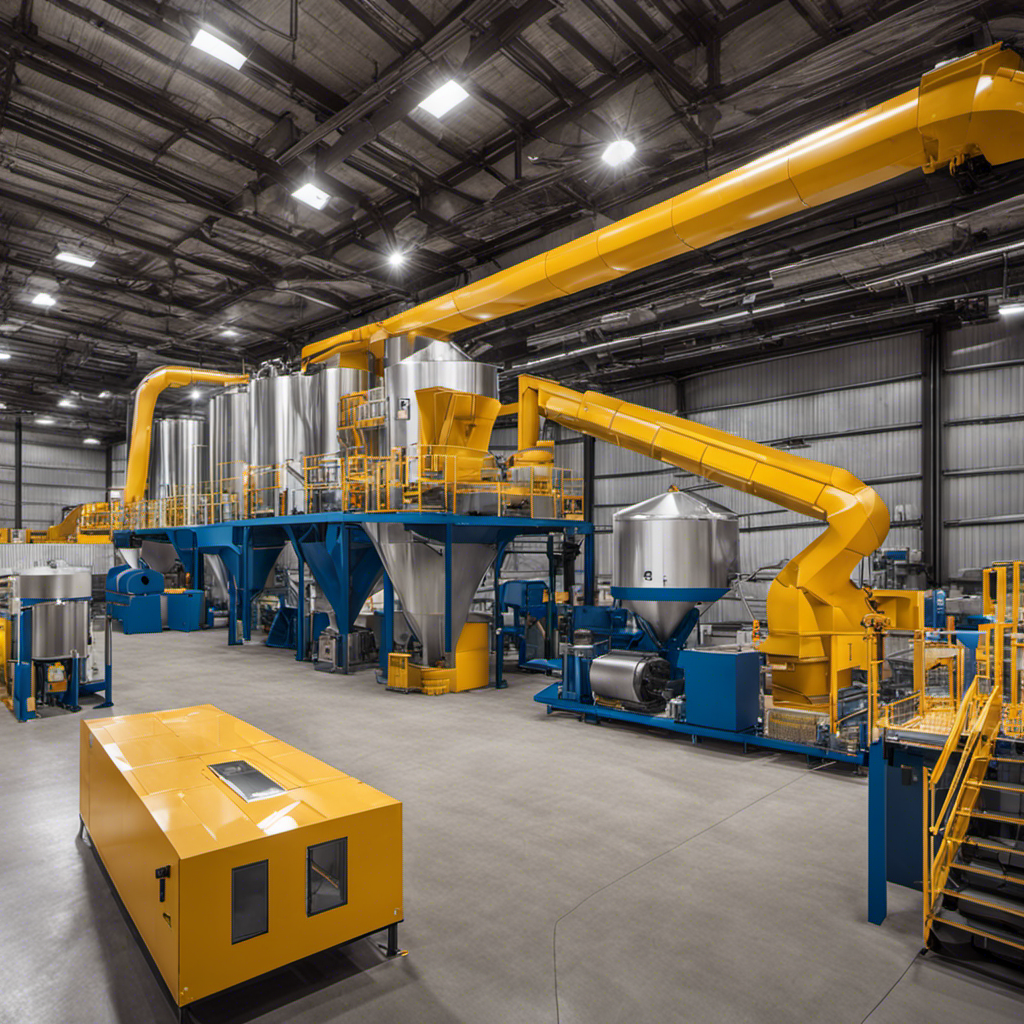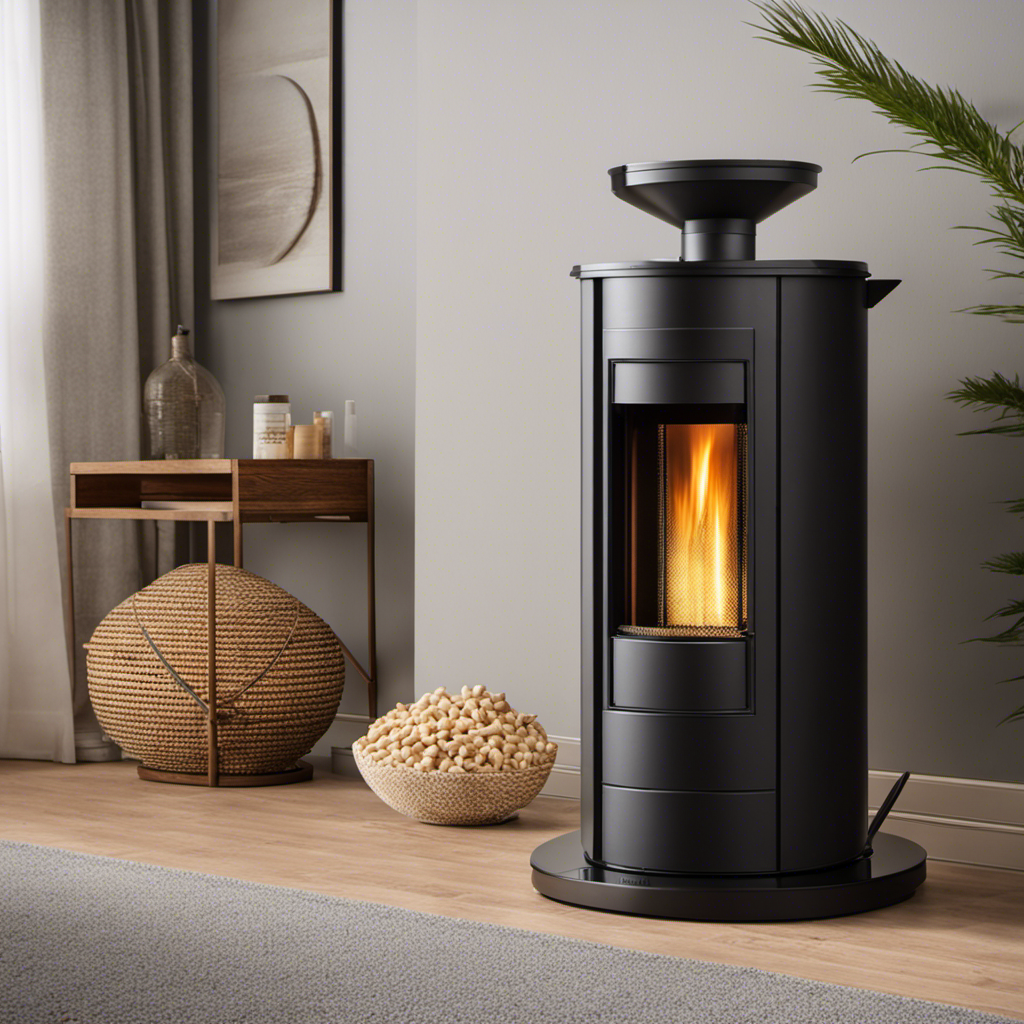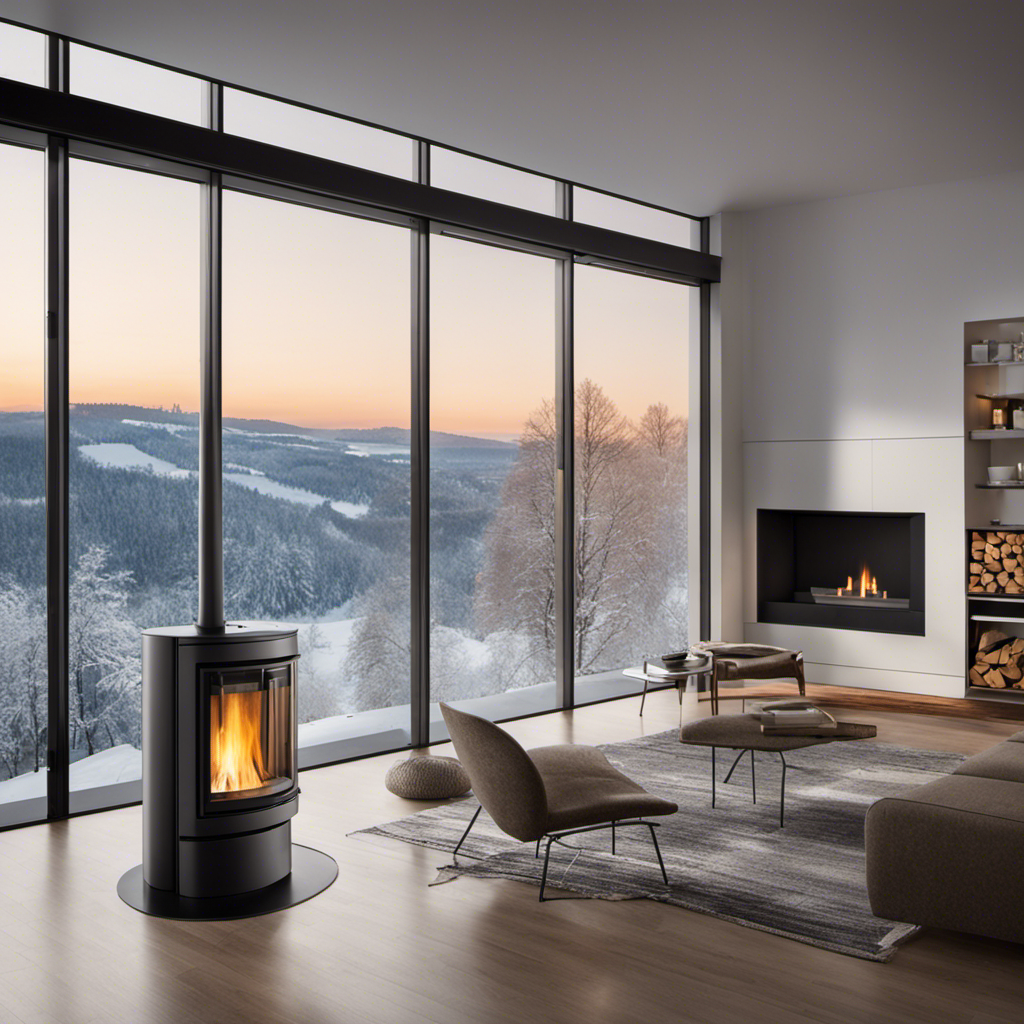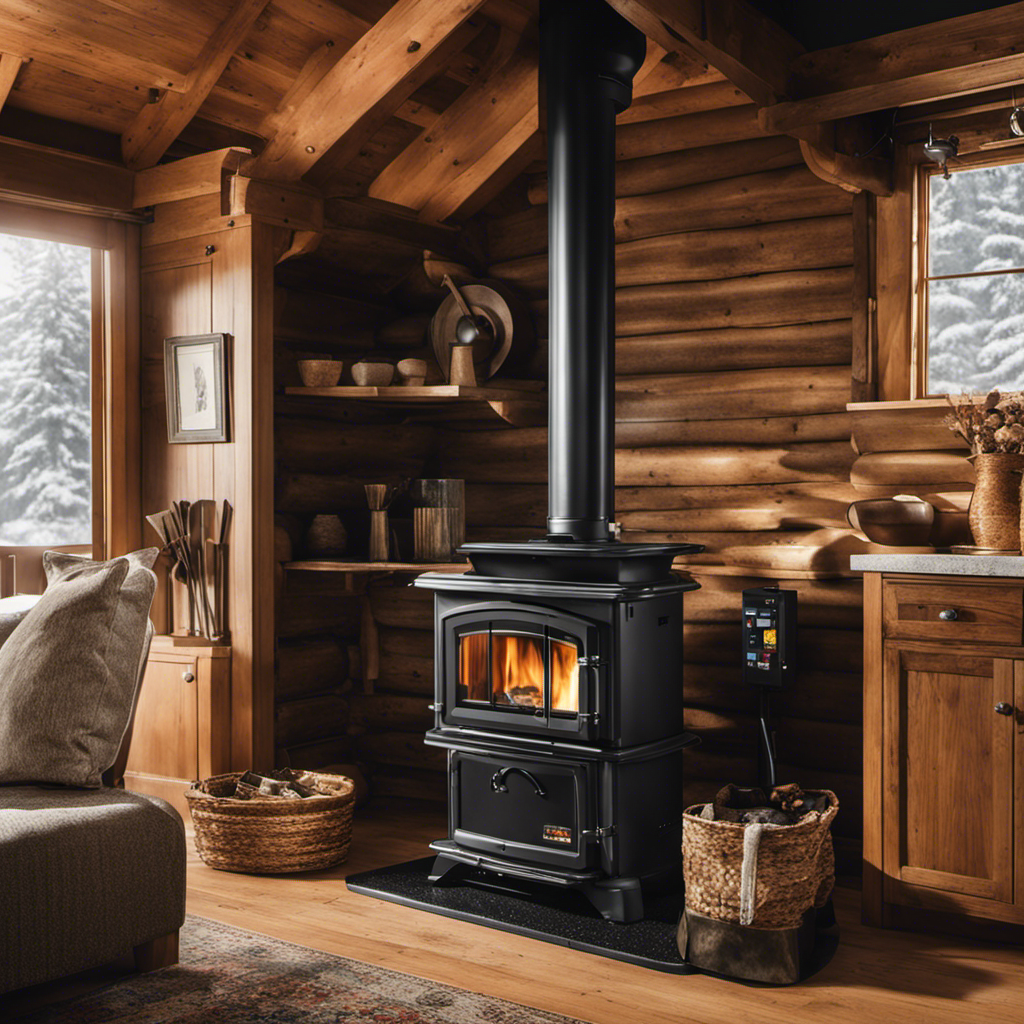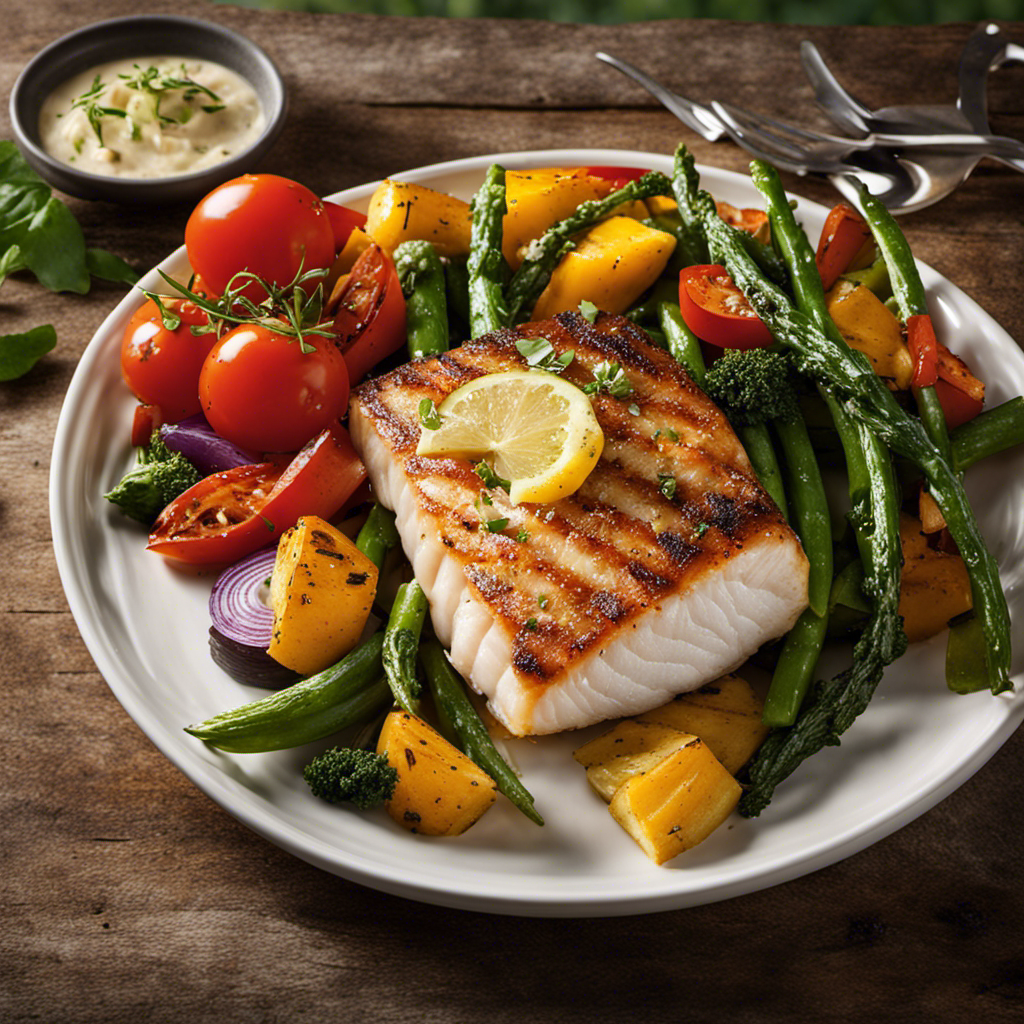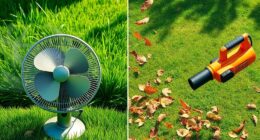Greetings, fellow grill enthusiasts!
Want to take your outdoor cooking game to the next level? Well, let me tell you about the wonders of a wood fire pellet grill.
It’s like having a smoky flavor party in your backyard! In this article, I’ll guide you through the steps of using this fantastic piece of equipment.
From selecting the perfect wood pellets to cleaning up after a mouthwatering feast, I’ve got you covered.
So grab your apron and get ready for some grilling greatness!
Key Takeaways
- Consider the desired flavor and smoke intensity when selecting wood pellets
- Clean and maintain the grill regularly for optimal performance
- Ensure even heat distribution for deliciously cooked food
- Proper preheating and ignition techniques are crucial for success
Selecting the Right Wood Pellets
To select the right wood pellets for your grill, you’ll want to consider the type of flavor and smoke intensity you desire. Different types of wood pellets offer unique flavor profiles that can enhance the taste of your food. For a mild and versatile flavor, go for fruitwood pellets like apple or cherry. If you prefer a stronger smoky taste, opt for hickory or mesquite pellets.
It’s important to store your wood pellets properly to maintain their quality and freshness. Keep them in a dry place, away from moisture, to prevent them from clumping or molding. Additionally, make sure to seal the bag tightly after each use.
Now that you have chosen the perfect wood pellets, let’s dive into preparing the grill for use.
Preparing the Grill for Use
When it comes to using a wood fire pellet grill, there are several key points to consider: cleaning and maintenance, heat distribution techniques, and preheating time and temperature.
As an avid griller, I have learned the importance of keeping the grill clean and well-maintained to ensure optimal performance.
Additionally, understanding how heat is distributed within the grill can greatly impact cooking results.
Lastly, knowing the right preheating time and temperature is crucial for achieving that perfect sear or slow-cooked tenderness.
Let’s dive into these topics to maximize our grilling experience!
Cleaning and Maintenance
Take a moment to clean your wood fire pellet grill by removing any leftover ash and debris. Keeping your grill clean not only ensures optimal performance, but also prolongs its lifespan.
Here are some cleaning techniques and maintenance tips to help you maintain your grill:
- Start by emptying the ash catch pan, removing any accumulated ash or debris.
- Use a wire brush or grill scraper to remove any stubborn residue on the grates.
- Wipe down the exterior of the grill with warm soapy water and a sponge.
Regularly cleaning your wood fire pellet grill is essential for maintaining its efficiency and preventing buildup that can affect heat distribution.
Speaking of which, let’s now explore some effective heat distribution techniques to take your grilling game to the next level.
Heat Distribution Techniques
Maintaining optimal heat distribution is key for achieving deliciously cooked food on your wood fire pellet grill. To ensure even cooking, there are a few heat distribution techniques that I have found to be highly effective.
First, make sure to arrange the pellets evenly in the hopper to ensure consistent fuel supply. Additionally, regularly clean the grease tray and drip pan to prevent any hot spots or temperature fluctuations.
Another technique is to rotate and flip your food during the grilling process, ensuring that all sides are evenly exposed to the heat. Lastly, using a deflector plate or diffuser can help distribute heat more evenly across the cooking surface.
Now let’s move on to preheating time and temperature…
Preheating Time and Temperature
To ensure optimal cooking results, you’ll want to start preheating your grill at the recommended temperature. Preheating is a crucial step in using a wood fire pellet grill. It allows for even heat distribution and helps achieve that perfect sear on your food.
Here are some tips to make the most of your preheating process:
- Use preheating accessories like grill grates or aluminum foil to help retain heat.
- Estimate the grilling time based on the desired internal temperature of your food.
- Keep an eye on the thermometer and adjust airflow accordingly to maintain consistent heat.
- Allow ample time for preheating, depending on the size and type of grill you’re using.
- Avoid opening the lid too frequently during preheating to prevent heat loss.
By following these guidelines, you’ll be well on your way to igniting the pellets and achieving the desired temperature for cooking perfection.
Now let’s dive into how to get those pellets burning and reach that ideal cooking temperature.
Igniting the Pellets and Achieving the Desired Temperature
Make sure you’re using the correct amount of wood pellets in order to ignite them and achieve your desired cooking temperature. Igniting wood pellets can be done using various techniques, each with its own advantages.
One popular method is using a chimney starter, which allows for quick ignition and minimal hassle. Another option is to use a propane torch or lighter to light the pellets directly. If you encounter any issues during the ignition process, here are some troubleshooting tips:
- Ensure proper airflow: Make sure there is sufficient ventilation around the pellet grill to allow for oxygen flow.
- Check pellet quality: Low-quality pellets may not ignite properly, so ensure you’re using high-quality ones.
- Clean the igniter: Over time, debris can accumulate on the igniter causing it to malfunction; clean it regularly.
By following these igniting techniques and troubleshooting tips, you’ll be well on your way to achieving the perfect cooking temperature.
Now let’s move on to controlling the temperature and smoke levels without missing a beat.
Controlling the Temperature and Smoke Levels
When it comes to achieving the perfect temperature and smoke levels on a wood fire pellet grill, there are a few key techniques that I have found to be highly effective.
First, controlling the temperature requires careful adjustment of the airflow by opening or closing the vents accordingly.
Additionally, using a digital thermometer can provide accurate readings and allow for precise temperature control.
Lastly, adjusting the smoke levels can be achieved by adding or reducing the amount of wood pellets used in the grill’s hopper.
Temperature Control Techniques
One key technique for controlling the temperature on a wood fire pellet grill is adjusting the airflow. By manipulating the amount of oxygen that reaches the fire, you can effectively raise or lower the heat inside the grill.
Here are some temperature control techniques I’ve found to be effective:
- Open the dampers: Increase airflow by opening both the top and bottom dampers fully.
- Close the dampers: Reduce airflow by closing both dampers partially.
- Use a windscreen: Shielding your grill from strong winds can help maintain a consistent temperature.
- Adjust fuel levels: Adding or removing pellets can impact heat output.
These temperature control techniques allow me to fine-tune my cooking experience on a wood fire pellet grill.
Now, let’s explore some smoke level adjustment tips without missing a beat.
Smoke Level Adjustment Tips
Adjusting the airflow on a wood fire pellet grill can also affect the level of smoke produced during cooking. By controlling the amount of oxygen that reaches the fire, you can enhance the smoke flavor and reduce smoking time for your food.
Increasing the airflow will result in a hotter fire with less smoke, perfect for when you want to quickly cook meats like steaks or burgers. On the other hand, decreasing the airflow will create a smokier environment, ideal for slow-cooking ribs or briskets.
Experimenting with different air settings will allow you to find the perfect balance between heat and smoke for each dish.
Now that we’ve covered how to adjust smoke levels, let’s move on to some tips for cooking different types of food on a wood fire pellet grill.
Tips for Cooking Different Types of Food on a Wood Fire Pellet Grill
To ensure your food cooks evenly and retains its natural flavors, you’ll want to experiment with different cooking temperatures and techniques on your wood fire pellet grill. Grilling techniques play a key role in achieving the desired flavor infusion for different types of food.
For meats like steak or chicken, searing them at high heat initially will help lock in the juices, followed by lowering the temperature to ensure they are cooked through. For delicate foods like fish or vegetables, using indirect heat and a lower temperature will prevent them from drying out.
By adjusting the settings on your wood fire pellet grill, you can achieve perfect results every time.
Now that you’ve mastered cooking on your wood fire pellet grill, let’s move on to cleaning and maintaining it for long-lasting performance.
Transition: Now that you’ve mastered cooking on your wood fire pellet grill, let’s move on to cleaning and maintaining it for long-lasting performance without compromising those delicious flavors.
Cleaning and Maintaining Your Wood Fire Pellet Grill
Now that you’ve mastered cooking on your wood fire pellet grill, it’s important to regularly clean and maintain it for optimal performance. Proper grill maintenance not only ensures that your food tastes delicious every time but also extends the lifespan of your grill.
Here are some essential steps to keep your wood fire pellet grill in top shape:
-
Clean the grates: Use a wire brush to remove any food particles or residue from the grates.
-
Empty and clean the grease tray: Grease buildup can affect the flavor of your food and even become a fire hazard.
-
Check and clean the burn pot: Remove any ash or debris from the burn pot to ensure proper airflow and combustion.
-
Wipe down the exterior: Use mild soap and water to clean the outside of your grill, removing any dirt or grease buildup.
Can the Same Method for Putting Out a Silo Wood Pellet Fire be Applied to a Wood Fire Pellet Grill?
Yes, the same method used to put out silo fire can be applied to a wood fire pellet grill. It involves using an extinguisher or large amounts of water to cool down the burning material and prevent further combustion. The key is to act quickly and safely to contain the fire.
Frequently Asked Questions
How Often Should I Clean My Wood Fire Pellet Grill?
I clean my wood fire pellet grill regularly to keep it in top shape. It’s important to maintain a clean cooking surface and remove any ash buildup. Follow these tips for maintaining your grill’s performance and longevity.
Can I Use Any Type of Wood Pellets in My Grill?
Yes, you can use different types of wood pellets in your grill. However, it’s important to choose the right type for the best flavor. Some popular options include hickory, mesquite, and applewood. Experiment and find your favorite!
How Long Does It Take for the Grill to Reach the Desired Temperature?
To reach the desired temperature on a wood fire pellet grill, it usually takes around 10-15 minutes for the grill to preheat. The sizzling heat brings anticipation, as flavors intensify and culinary magic begins.
Can I Use the Wood Fire Pellet Grill in Cold Weather?
Yes, you can use a wood fire pellet grill in cold weather. Here are some tips for maintaining temperature in freezing temperatures: insulate the grill, preheat it longer, and consider using a thermal blanket.
Can I Leave the Wood Fire Pellet Grill Unattended While Cooking?
I never leave my wood fire pellet grill unattended while cooking. It’s all about cooking safety and grill maintenance. I want to make sure everything is under control and enjoy the process.
Conclusion
In conclusion, using a wood fire pellet grill is a game changer for any grilling enthusiast. The versatility of being able to control the temperature and smoke levels allows for endless possibilities when cooking different types of food.
With the right wood pellets and proper maintenance, your grill will consistently deliver mouthwatering results. So why settle for ordinary grilling when you can elevate your culinary skills with a wood fire pellet grill?
Get ready to ignite your passion for outdoor cooking and savor every flavorful bite.
Growing up surrounded by the vast beauty of nature, Sierra was always drawn to the call of the wild. While others sought the comfort of the familiar, she ventured out, embracing the unpredictable and finding stories in the heartbeat of nature.
At the epicenter of every remarkable venture lies a dynamic team—a fusion of diverse talents, visions, and passions. The essence of Best Small Wood Stoves is crafted and refined by such a trio: Sierra, Logan, and Terra. Their collective expertise has transformed the platform into a leading authority on small wood stoves, radiating warmth and knowledge in equal measure.

